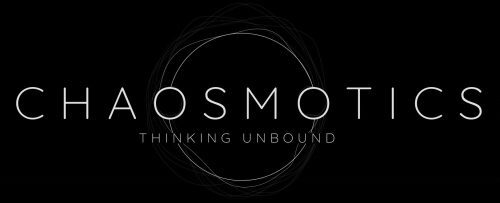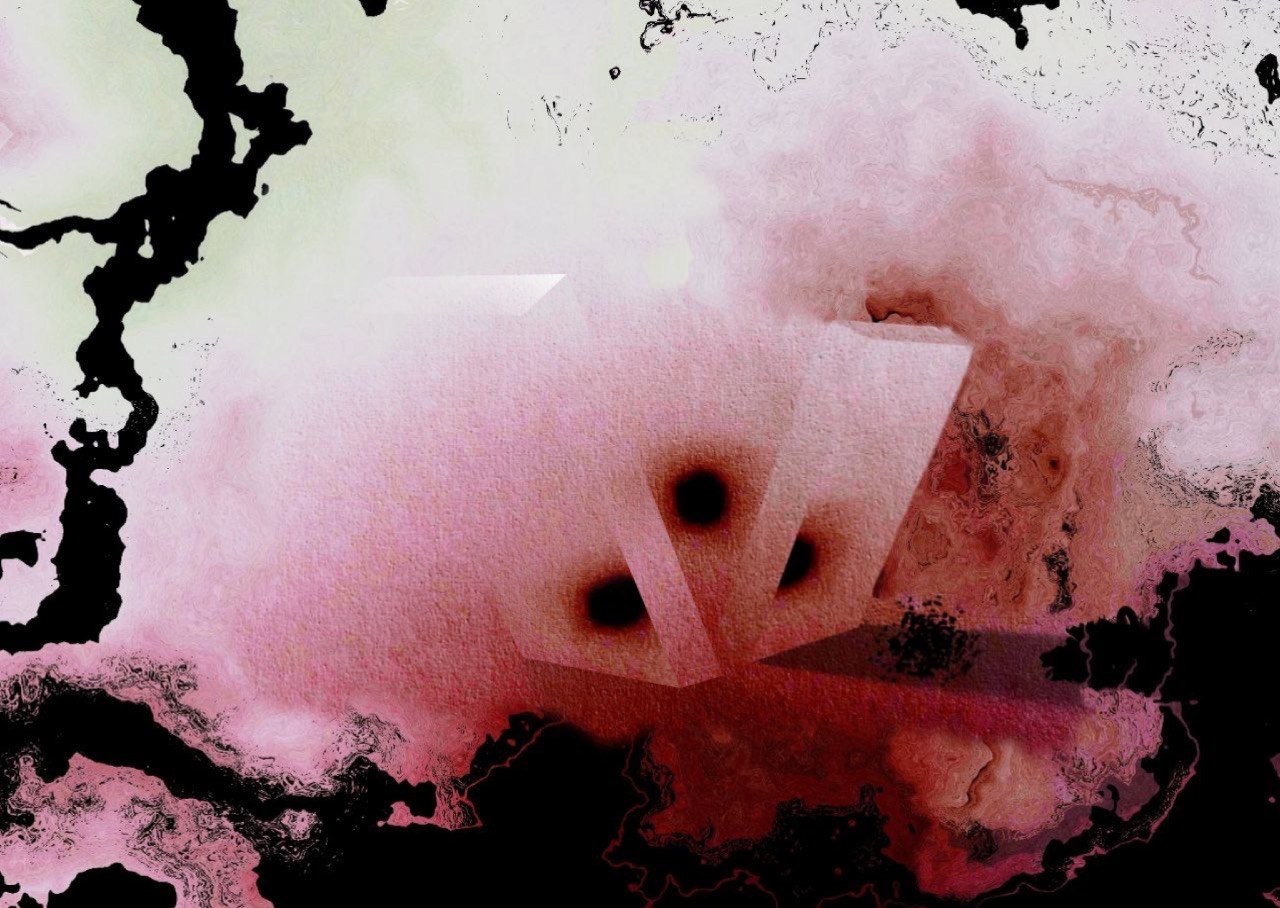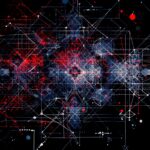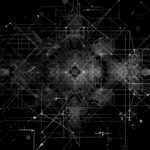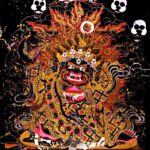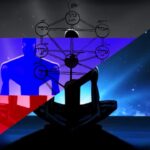I am so sick I have forgotten I am sick. That I can
remember this forgetting, but not what was forgotten, means
that any final cure, should it ever come, will arrive
not from the future but the past.
– G. J. Shipley1
The notion of inhumaine, which Lyotard developed in the second half of the 1980s, represents the ultimate sophistication of his attempt to think about the relationship between matter and time. On the one hand, there is the inhuman which precedes anthropos and its immense and heavy connotations, which precedes humanism as a totalising and monological discourse; on the other hand, there is the inhuman of capital and techno-logos, a product of modernity and based on the principle of performance, and the criterion of efficiency2. Man produces artificial apparatuses that simulate certain functions of the brain, and it happens that man observes and imitates these apparatuses in turn, using them as reference points for himself. It then happens that man imitates the machine that imitates him – the inhuman that follows neutralises the inhuman that precedes. Compositions between organic and inorganic bodies are ultimately equations between elements purified by a dual process: the technical body, which imitates the organic one, is observed by the latter as a model to strive towards. Thus the present image hopes to materialise in the future image, a familiar repetition within the confines of empire, an escape route from the violence of disintegration.
According to Ashley Woodward, Lyotard’s focus on the passage is primarily on ensuring the incommensurability of meaning and existence. That is, “to allow thought to have a space in which it is responsible only for itself and not for life, and equally to guarantee life a space in which it is responsible for itself and not for thought”3. The boundaries between these two spaces, however, cannot be kept impermeable – Woodward uses the verb “to police”, which well indicates repressive surveillance. On the contrary, the task that thought sets itself is to think about the passages between these boundaries, their modalities. This form of speculative activity, Woodward notes, is what Lyotard calls judgement: that “thought [guided by feeling] which by necessity must judge without recourse to any pre-existing set of rules or criteria”4. Judgement establishes passages between the islands of an archipelago (symbolising the heterogeneity of thought), thus creating channels of communication and exchange between them. However, judgement does not create bridges or “agreements” between the different faculties5 or language games: each time it hoists its sails and sets sail again, ploughing the waters again. This is the realm of interaction, not creation.
Judgment understood in this way is based, for Lyotard, on the pre-anthropo-logical dimension of the inhuman as its primary mode of interaction with the real. In this he is clear: the inhuman, understood in this way, is the field of resistance that opposes the inhuman of techno-logos. This resistance is the re-presentation, mediated and channelled, of the resistance of the world in anthropos itself, in its being enclosed to itself. And so the inhuman retains the whole of all those horizons that are difficult to integrate, censored, dismissed, separated from the representation of the “human essence”: childhood, the unconscious. In particular, childhood contains profound speculative potential, since it appears not only as the age of life in which the interweaving of thought and feeling is inseparable – in which one faces existence in the manner of judgement, but is also the dimension that informs judgement itself. In Lyotard’s idea, this results as the faculty of renewal of interactions, relations, orders and paradigms: the movement that relates the amorphous and the form, deployed in an act of purification that is always original. Judgement is the horizon of the real passage, of its happening without leaving a trace inscribed in the memory, but which nevertheless insists and survives in the unconscious. Thus krisis certainly takes on the meaning of judgement6, as an instant of rupture of time, in which every premise of the event fails to be inscribed in a narrative. If crisis presupposes that nothing is hidden, concealment is instead the essence of the passage. But the former is but a reflection of the latter – a reflection of a peculiar nature.
***
The operation of placing an object against itself, as in front of a mirror, Lyotard often repeats. It is a strategy that originates from the continuous attempt to counterpose the oppositions of the realm of the concept with the disparities of abstract art, which he discusses in a close manner in the last chapter of his book-heresy, Libidinal Economy. The identities (“the this in this and the that in that”7) elicit from themselves fleeting glimpses of their continuous surface, of their potential reopening (since they appear as closed organic bodies, invaginations). Re-opening is given, for Lyotard, in the mirroring. The inhuman splits; in itself it displays a bimodal nature, a double movement, in which no truth is unveiled or produced. If the Hegelian dialectic is affirmative and productive – the encounter between unstable and opposing figures generates a result, a conquest – Lyotard enacts a work of internal dismemberment. The end of this particular intra-identity dialectic is deprivation: the play of reflexes between “inhumanities” would be resolved in the dissolution of every instance. In the awareness of the “continuous fragmentation of all things”. This is the point at which Lyotard meets Dōgen and the clear mirror.
Postmodernity does not represent any kind of epochal break, nor does it represent a relay between Weltanschaaungen. Postmodernity is a possibility of modernity itself, always already present within it, since “a work can only become modern if it is in the first instance postmodern”8 – that is, it must first generate disquiet and incomprehension, before being inscribed in the nomos. If Woodward recognises two different “moments” in Lyotard, the one revolving around the postmodern condition and the one relating to the inhuman condition, for Yuk Hui, in the wake of other readers such as Veerman9, the two moments are part of the same, coherent phase, following the publication of Libidinal Economy. Modernity-postmodernity respects the logic underlying the inhuman-inhuman opposition, that is, a logic inextricably linked to time. Not a logic of time, but of passages: the realm in which time and matter manifest their intertwining. If the postmodern is in fact the condition through which something modern can appear, the “infantile” inhuman is the condition of the technological inhuman. The encounter between the two poles of the same element does not lead to an identification, a material repair, but to a concatenated, contagious fragmentation: the domain of non-(modern, human, philosophical, being…).
“It took two centuries for Greek thinkers to discover the idea of privation. Only Plato was able to understand this negation-as-privation, and he discussed it in the dialogue The Sophist”10. Privation is not a form of absolute negation, but rather a “reversal of direction”11. Postmodernity thus does not appear as the absolute negation of modernity, not-modernity, but rather the autonegation of modernity within itself, non-modernity. The modern, if it is not postmodern, “is nothing” – literally. Not Nichts, but not a subsistent identity either. Ultimately, the point around which Lyotardian reflection revolves, in this dance of disparities concealed in disjunctions, is the encounter between logos and techno-logos. “Can being be, without leaning on a support, a hypokeimenon?” asks Yuk Hui, heralding Lyotard’s question. Can the techno-logos be the autonegation of the logos itself?
***
In order to understand the way Lyotard arrives at his question, it is necessary to reconnect with two notions: anamnesis, and “clear mirror”. Anamnesis appears as a mode of memory already in Plato, in the Phaedo and especially in the Meno, where there is the account of the servant who is helped by Socrates to extract a “lost” content from his memory. In that case, the servant solves a geometry problem without knowing the subject matter. With such an experiment, Plato wants to demonstrate how knowledge is nothing more than a memory that one re-appropriates, proof of the conformity between mind and world and of the similar nature of all things – to the re-appropriation of one knowledge, any other can potentially follow if the path is corroborated by proper education, the paidéia. Similarity is unity, but it is particularly so with regard to the immortal soul: Plato in fact affirms the separation (chōrismós) between Idea and matter. If, for Plato, anamnesis therefore does not need material support, Stiegler in Technics and Time, emphasises how drawing the square in the sand is the tool needed by the Socrates of the Meno in order to complete the maieutic task. The anamnesis is thus doubly linked to technique, according to Stiegler: “anamnesis is not possible without a support that is external to the noetic soul”12.
For Lyotard, there are three different temporal syntheses through which materiality can re-present itself: habit, i.e. embedded memory; remembrance, discussed above; and anamnesis. To each of these corresponds a type of memory-effect, respectively: trace, construction, passage. “Habit rests on a trace”, a set of neurochemical and cognitive elements that lead the body to assimilate and repeat an action with minimal expenditure of energy. Construction, or reconstruction, on the other hand, is the figure of remembrance: the past is recovered as past and synthesised in an image with which one identifies, and in which the dimension of inscription is given by language as technique. A language that defines, and that equally limits – that becomes the support of a recovery aimed at generating, but also remains entangled in the necessity of its rules and structures. “The history of life on our planet”, reflects Lyotard, “cannot be assimilated to the history of technics in the current sense, since it has not progressed through remembrance, but through a continuous opening up of paths”13. The passage, on the other hand, explicated in anamnesis, is characterised by its difference from “habitual experimentation” and “voluntary remembrance”. Here Lyotard brings into play Freud and his Durcharbeitung – traversal, reworking. Overccoming synthesis, expressed in the technique of passing as “non-regulation”14: in the Durcharbeitung, in fact, there is no rule that the patient must follow, nor that the analyst must impose. Only thus will the emergence of the non-inscribed be possible through what is inscribed in the word, in the patient’s synthetic memory. Or in the writing, articulation and expression of a dimension non-expressible by the writing itself, in the sense of different from what is expressed but nevertheless present, insistent, and elusive. The object of the anamnesis is an origin that is non-inscribed but cannot be forgotten – like childhood, a dimension that Lyotard will attempt to dialogue with several times throughout his work.
In order to describe this presence, Lyotard recalls the Zen master Dōgen, and the metaphor of the clear mirror.
I borrow from Dôgen, from one of the treatises of the Shobogenzō, the Zenki15, this metaphor of the mirror: it is possible to have a presence that the mirror cannot reflect, but shatters it into splinters. A foreigner, a Chinese person can appear before the mirror and their image be reflected. But if what Dōgen calls a “clear mirror” is in front of the mirror, then “everything will shatter into splinters”. And Dōgen points out: “do not imagine that there is first the time when the crumbling is not yet there, nor that there is the time when everything crumbles. It is simply the crumbling (Shobogenzō, p. 106-107). There is thus a crumbling presence, it is never inscribed nor can it be remembered. It does not appear. It is not a forgotten inscription, it has no place or moment on the inscription stand, in the reflecting mirror. It remains ignored by traces and reconstructions.16
According to Yuk Hui, what Lyotard attempts to do by referring to the question of the clear mirror is to establish a logic of the anamnesis and negation of the logos by means of the techno-logos; it is, by referring back to Socrates’ drawing in the sand, a question that directly concerns the interaction between matter and time. “The clear mirror is not a mirror: rather, it is a possibility of the mind, in front of which nothing exists for what it is: things can exist or not exist”17. If the form of substance, of matter, through which the logos is performative is configured as a support (for speech, for writing, for thought), the question then revolves around the possibility of the being of thought without support – in what is sketched by Plato as “being beyond essence”, by Heidegger as Lichtung. And which Hegel fails to observe in that instant when the Logic is set in motion.
Yuk Hui retrieves another example of such logic in Dōgen, when the Zen master asks a pupil to think about nothingness. In the apparent impossibility of such a request (thinking about something, even to the negation of thought itself, is an act of thinking), a third way emerges between thinking and nothingness: non-thinking. This is the thinking proper to the Zen doctrine, in which the mind is traversed by elements that do not follow any rules of manifestation and cannot cling to anything. In Zen in the Art of Archery, Eugen Herrigel, bringing to mind his kyūdō lessons in Japan between 1924 and 1929 – which are in the first instance lessons on Zen doctrine – writes that the particular condition of the mind required to make the right complex of movements to shoot the arrow “cannot be conceived intellectually, indeed it cannot be grasped and explained even after one has experienced it, however precise and incontrovertible: one knows it by non-knowing it”18. That thing, that small and immense secret that Lyotard tries to define as the field of the passage in which the interaction between matter and time is shown with its concreteness, undermines that horizon of wisdom so familiar to the West. Is this what Western thought has not come to think? asks Lyotard. The astonishment that runs through Herrigel’s little memoir in approaching zazen is already an anamnesis.
***
“Anamnesis would be this monition, this caution, this warning […] of turning (ana-) to the clear mirror, through the shatters”19. Modernity, post-modernity, non-modernity: what appears enclosed and defined dissolves again. Human, post-human, inhuman: the essence that seeks its own transformation – a transformation that is already already contained in the essence – makes everything that, while insisting, is not inscribed and cannot be inscribed, re-emerge from the cracks. Like Sierra’s filth, another effective manifestation of a non- which re-swallows, operating by deprivation (the filth is non-technological precisely because it collects those aspects of technology that neutralise it in the theory of the technological). Finally – in Lyotard – logos, techno-logos, non-logos: the techno-logos, already contained in the logos as the ultimate expression of the inscription of thought on an external support, may be the realisation of a different conception of materiality – the one of which the new digital technologies are bearers; a conception that undermines logos itself.
Why therefore is Plato so obsessed with the divine and its rescue? Why does he observe with disgust and concern the sophists who question the very consistency of the world and knowledge? The sophists’ assertion of the conventionality of nomos is in itself a world-shaking statement. And if they then add that what is ignored cannot be acknowledged, and so neither can it be pursued (in response to questions such as what is virtue?), the world becomes nothing more than a heap of splinters, and speech an almighty instrument of affirmation of what a mind possesses, without any discernment between the right and the wrong. Thought, thus, is but a téchne; the world is lost at the start, distant, inapprehensible. The Platonic solution is as metaphorical as it is incredible: the soul does indeed know everything because it is similar to everything, and eternal, but with each incarnation it forgets its past lives, and must be able to recover its memories – by means of anamnesis. The philosopher is the one who is partly graced by the oblivion of the River Lete: she remembers that she no longer remembers. This logic, the remembering of not remembering, is exactly what Yuk Hui defines as the logic of the Lyotardian anamnesis, the game of the clear mirror. The sense of possessing something that cannot be manifested, of being traversed and composed by a dimension that cannot be expressed – Freudian resistance, but without the analytical part: effects without causes – is exactly what cannot be inscribed, what is not inscribed, and what resists the logos. Thus the philosopher is related to Eros, halfway between the god and the ignorant man, because he is always tense in this feeling of non-possession and search. The divine then serves Plato to manifest this domination of the Other, of the non- producing tension, but which is not inscribed in the logos. Plato’s error, and that of the Western tradition, then, is denoted in the reduction of this Other to the logos, or in the idea that the latter acts as a medium for the former, as the organon of an impossible inscription, since it is always incomplete, approximate. The East, on the other hand, structured the question differently: ‘Think of not-thinking. How can you think of not-thinking? Not thinking’. With each step, the Other as unity is renewed.
The One whose form emerges in the Platonic anamnesis is an Otherness that is defined in the similitude (sungenḗs) of the things of nature. This similitude is what precedes particular entities and makes them intelligible – it is the world of the Idea, the field of pure Being that invests matter. The latter, of course, cannot itself be a particular determination of the entity, but it is the Being of every entity, which in the first instance allows the entity to be open to understanding. Being is not derivable from being, for Heidegger, nor is it thinkable in the simile, as Plato claims. Rather, it is difference: despite being in all entities, Being is none of them, and differs from them in its absence of determinations. Severino would add to the Heideggerian problematic of ontological difference the fact that this difference characterises Being as Non-being; when Heidegger states that Sein ist Nichts (Being is Nothingness), he does not mean to deny Being in absolute, but as the determined nothingness that unites all entities20. Severino then recognises that what unites entities and Being is non-being-nothingness: an original dimension, prior to ontological difference itself. Unity, in a sense very close to what Zen defines as non-thinking, and which Lyotard attempts to develop as privative dialectics.
***
A thought that stands before non-thinking, like a mirror before a clear mirror, manifests “continuous shattering” that has no beginning and no end, but is constant. The shattering of identities, of syntheses of identities, and also of determined differences. Anamnesis thus appears as the method of regaining this dimension of non-thinking, of childhood, of remembering-of-not-remembering. To regain a unity, then, that is nothing but presented and never thought – continuity. Lyotard himself posits as the goal of philosophy, in commonality with Hegel, the attempt to re-establish a lost unity21. But in contrast to Hegel, the anamnesic method is not systematising, and unity is never possessed; it proceeds without rules, and with great difficulty, to redefine the interaction between matter and time in the passage. A unity that produces and nourishes difference and that, as with other (literally) speculative operations, stands before its reflection, the totalising and totalitarian unity of modern discourse.
Why is it so important for Lyotard to pursue such an ontological question in order to think techno-logos and its new materiality? Why the obsession with the domain of the non-inscribed, hence with what precedes “the passage between childhood and thought”22, and with childhood itself? In the first instance, childhood is for Lyotard the entry point through which the West can come to think what the East has developed as non-thought, for it is that realm which Freud defines as that of what is not remembered, but which continues to constantly insist on the psyche. Anamnesis, which operates without rules, is therefore a form of resistance to any systematisation and thus to any form of inscription23, as well as a field of manifestation of the differénd within logos itself. The system is the representation of the Heideggerian technological understanding of being, or of the Enlightenment terroristic reason: domestication, domination, opposition of a subject and an object. The system is the method of inscription of the logos, which is externalised in material supports in the techno-logos. Observing the development of new technologies of telecommunication and storage, and thus a whole new materiality composed of fleeting, free, and continually evolving interactions, Lyotard wonders whether this “immaterial matter” might not entail the inversion of the logos itself: a domain in which the specificity of the relationship between thought and matter dissolves into the immatériaux. Believing in one’s own illusions: defining the domain of thought in effects (of interactions), and not in causes (in the logical concatenation that seeks foundation in an impossible real)24. Man becomes an interface, showing the limits of logos as a form of dominion of a subject over an object. The clear mirror thus recalls the ineffable presence of something between forms, before forms, and which manifests them as fragments. It places discourses on the same level, maintaining their incommensurability, and avoiding the affirmation and legitimisation of one discourse over others. Thought has responsibility only for itself.
What is at stake in Germán Sierra’s reflection on non-technology lies precisely in the recovery of a form of unity. Or of a dis-formity of unity, conceiving in fact the commonality between organic and inorganic body as an inversion of the concept of function, and also of technology. In the performativity of the technical object is certainly inherent the accident, as Virilio suggests, but even more implicit is its fundamental in-efficiency, its production of dross and residues that undermine its status.
The problem with the cyborg model hypothesis, at least for theoretical purposes, is that it excludes all the non-technical aspects of both human bodies and digital objects, that is, all those aspects of excess that are often overlooked in order to facilitate correct, symbolic, human-machine communication25.
Filth is then the material condition that undermines matter itself, insofar as it is systematised, classified, thought out, and in a certain way determined. Filth, in the impossibility of suspension, (epoché), as amorphous swallowing up the form, the miasma, the damp, putrescent mass, is a mode of anamnesis – an aspect of the clear mirror, resistance to thinkability and systematisation: pure effect, for which any analysis (search for causes) is completely ineffective. A mass of bodies in the process of decay or corrosion become the field in which specificities are lost and identities are not possible. The filth is only one aspect of the clear mirror as it still needs a support, the body or matter in general, from which to manifest itself. Thus metamorphosis seeks in the filth, in turn, its own support, not in a productive or generative impulse, but purely subtractive. The filth is for the technical object its end precisely because it is technical: the manifestation of an inconceivability (the differénd) within the form itself, perpetual fragmentation.
The (non-)dialectic at work between filthiness and purity, modernity and post-modernity, humanity, inhumanity and post-humanity cannot be defined solely as an operation of dismantling and reconstruction a la Nietzsche, precisely because it goes beyond the very scope of reconstruction through anamnesis. What is at stake is the dismantling of generative strategies. Not separation and extraction, but a compulsive backing away that allows the interactions between things to manifest anew. The question of the passage between human and posthuman, for example, must be thought of precisely from within the passage, from what such a profound crisis of the human has in common with what happened thousands of years ago in Gobekli Tepe, or even earlier, in the long day when the symbolic separation between predator and prey, between man and animal, took place. That succession of forms, placed before the clear mirror, reveals their character as fragments and splinters. The primordial nature of the divinities, their familiarity in metamorphosis, the secret and irreducible ambivalence of the sacred, already represented a form of impossible remembrance, of sense-of-remembrance of something that could not be inscribed but which persists in a relationship with the animal, writes Calasso, which appears throughout the journey of thought as a field of inexplicable radical otherness. Otherness that is “the condition of différend“26 and returns overbearingly in various forms from within identities – the dialectic of the clear mirror as the Other of the Western logos; the animal as the Other of man; the inorganic body as the Other of the organic body. This is to say that at bottom, if it has any meaning, the passages are multiple, and in this they are One.
Calasso notes how the divine that Plato defends is different from the object of the sacred understood as the violence of metamorphosis. There are no gods that become animals, men, objects, in Plato: the focus on the conformity between mind and world, of the identity of the Ideas in themselves, underlies the anamnesis understood as the recovery of Being by means of entities, which therefore cannot vary; this is why mathematics and numerical ratios are so important – and why the discovery of the incommensurable will be the opening of a chasm in the watermark of the world. The Platonic divine is only the hint of a sacredness far more ancient, and far less determined by purity. It is itself an unfinished anamnesis, the remembering of not remembering the ineffable. Even with Plato, the metamorphosis continues to be lost. The sacred as warning gives way to the sacred as law. Five centuries later, Plotinus will take up Plato’s teachings, concealing a great capacity for renewal behind the Athenian’s task of tidying up and completing his thoughts. Plotinus is not interested in politeia, but in life understood in the most general way, zoé – and in the unity of all things in nature. So that, Calasso observes, it is necessary that evil, war, violence are also part of unity, without there being too much scandal in affirming this. “Logos needs differences in order to be, and the greatest difference is opposition”27; Plotinian unity originates and is perfected in conflict, which is the simplest interaction. This is how Plotinus introduces the utility of evil, an absolute novelty in philosophical thought, a recurring memory in ritual: “this belongs to the greatest power: to make evil serve good, and to be able to use what has become formless to make other forms“28. As if to say that in the conflict between forms, in the exhaustion of figures, in the crisis, the passage is the place where an ungraspable continuity opens up. In Lyotard’s metaphor of the archipelago, unity is to be renewed by still walking the stretches of sea as if they had never been walked, because no traces remain in the sea, and no hull ever surfs the same wave twice. Recover the scattered fragments and rearrange thinking on the basis of the new interactions that the world presents to us. What is the body before biomedical engineering? What is matter before information? What is life before entropy? Evil, the tendency to hold forms in their disintegration as if they were not always fragmented, is indispensable to the awareness that each passage is one. Evil is not horror in itself; it is horror for eternity.
***
In The Destiny of Man, Berdyaev writes that the human “no longer desiring to identify himself with the image of God, then becomes the image of the machine”29. In a machinised world, man himself becomes a machine: the crisis of spirituality is for Berdyaev already, paradoxically, the end of this very crisis and the affirmation of something else. By losing God, says Berdyaev, who made him in his own image, man loses himself – but the danger of disintegration is too great a threat, and new strategies are set in motion. When Turing establishes “that the ‘states of mind’ hypothesised for his machine could be counted”30, he does so not out of conviction but out of a convenient approximation. “If we were to admit,” he writes in On Computable Numbers, “an infinity of states of mind, some would be ‘arbitrarily close’ and get confused”31. Calasso subtly intercepts the threat Turing felt: “it was necessary to dodge the continuum and therefore to treat the states of mind as something they manifestly are not: single, well-separated blocks”32.
Turing knew full well that the nervous system was not a discrete-state machine like the universal machine he had devised in 1935. On the contrary, he pointed out that ‘strictly speaking there are no such machines. In reality, everything moves continuously’. […] The brain is not and can never be a discrete-state machine but, in various circumstances and for different reasons, it simulates being one.33
The Turing machine circumscribes an operation of the brain and replicates it; it simulates the brain in the act of simulating. Thus neglecting an immense archipelago, and lowering the sails of the galleon that, each day anew, should have crossed the space between the islands. The brain observes itself in the machine, as if in front of a mirror. If the reflection returns the image, which appears as a restitution with which to identify oneself, purification takes place in an increasingly sophisticated manner. But if, for some absurd reason, the mirror did not reflect what is in front of it, but was empty, clear, resistant to all productive and determinative play, like a wave perpetually retreating to the grip of the beach, everything would be shattered as it has always been. And among the shattered: a ship, in constant motion. In front of the Turing machine, the brain will not seek the machine, will not create the machine, but will retract into itself to define the interaction and the meaning of the interaction between itself and the machine. Every new, possible relationship is not just a return to questions (Arendt), but a return to childhood. A rite of death and rebirth; a rite of passage.
- On the Verge of Nothing, Nine-Banded Books, Charleston, 2021, p. 42
- Woodward writes of this meaning of the inhuman: “the contemporary global system which no longer functions even in the pretence of bettering humanity, but according to the criterion of performativity or efficiency which is the result of the combined logic of capital and technoscience” (Lyotard and the Inhuman Condition, Edinburgh University Press, 2016, p. 5)
- ivi, p. 36
- idem
- in contrast to the notion of consensus and communicative transparency that Habermas develops, and towards which Lyotard cultivates the same suspicion as towards the great emancipatory metanarratives. Cf. M. Peters, Lyotard, Education and the Problem of Capitalism in the Postmodern Condition, ERIC, International Meeting on Education (Chicago), 1997
- as in Demosthenes or Sophocles, cited earlier
- Lyotard, op. cit., 2012, p. 267
- Lyotard, The Postmodern Condition: a Report on Knowledge, University of Minnesota Press, 1984, p. 79
- D. Veerman, “Introduction to Lyotard”, in Theory, Culture & Society, SAGE London, vol. 5, 1988, 271-5
- Heidegger, Zollikon Seminars: Protocols, Conversations, Letters, 46-47
- Y. Hui, A. Broeckmann, 30 Years after Les Immatériaux, meson press (Hybrid Publishing Lab), 2015, p. 187. Yuk Hui takes up the example of Heidegger’s skiing to explain deprivation: “When I am asked if I have time for skiing, I reply, “no, I don’t have time”. In fact, I do have time, but I don’t have time for you.”
- ivi, p. 184
- Lyotard, op. cit., 2015, p. 77
- ivi, p. 80
- The treatise Lyotard is referring to is actually the Kokyō, a long passage in which Dogen reflects on the relationship between the Old Mirror and the Clear Mirror in Zen doctrine. The reference to Zenki, a much shorter chapter dealing with life and death, is a mistake.
- ivi, p. 81
- Yuk Hui, op. cit., 2015, p. 188 (my italics)
- E. Herrigel, Zen in the Art of Archery, Vintage, London, 1999, p. 24
- Lyotard, op. cit., p. 82
- See. E. Severino, Heidegger e la metafisica, Adelphi, Milano, 1994
- Woodward, op. cit., 2016, pp. 56-61
- ivi, p. 23
- Yuk Hui, op. cit, 2015, p. 201
- Lyotard, op. cit., 1993, pp. 252-254
- G. Sierra, “Filth as Non-technology”, in Keep it Dirty, vol. a., 2016, p. 11
- Yuk Hui, op. cit., 2015, p. 180
- Plotinus, Enneads, III, 2, 16, 54
- ivi, III, 2, 5, 23-25, (my italics)
- N. Berdyaev, The Destiny of Man, trans. B. Jakim, Semantron Press, 2009, p. 36
- Calasso, op. cit., 2016, p. 131
- A. Turing, On Computable Numbers, in The Essential Turing, B.J. Copeland ed., Oxford University Press, New York, 2004, p. 79
- Calasso, op. cit., 2016, p. 131
- ivi., p. 132

